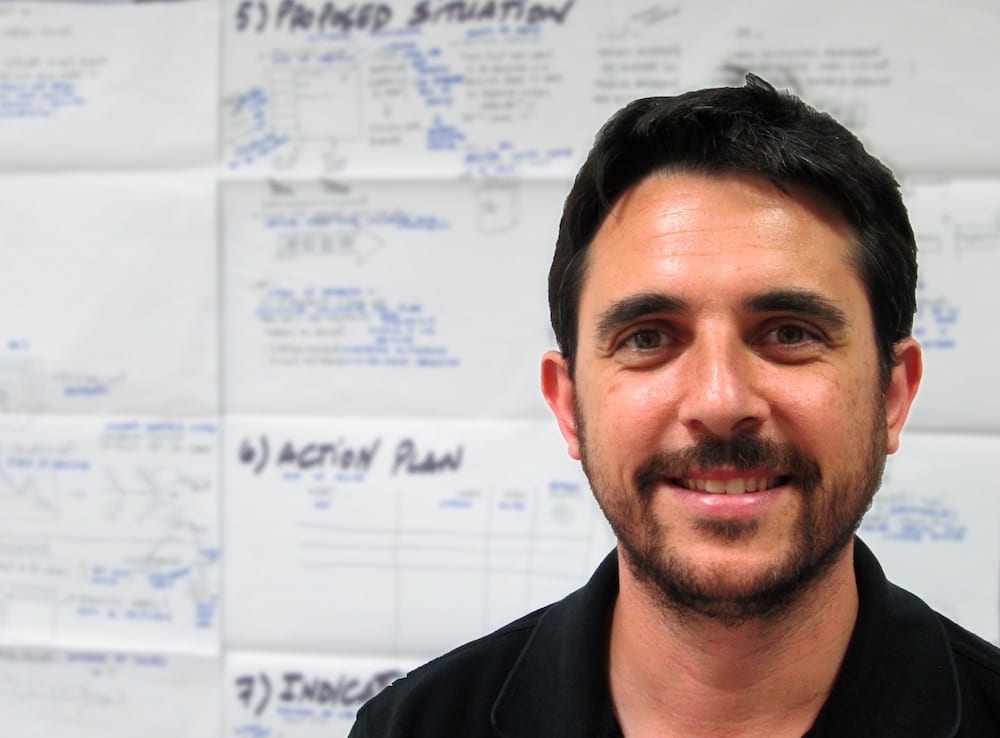
Leadership: tackling the P in SQDCP
FEATURE – Whether or not a lean transformation succeeds largely depends on management behaviors. This assessment tools helps you understand what leadership traits you need to develop to achieve your goals.
Words: Nestor Gavilan and Eva Fernandez
Walk the gemba in any lean organization and you’ll quick notice the well-known SQDC (Safety, Quality, Delivery, Cost) on its visual management. Some of them add an M (for Morale) or P (for People) but, even when they do, they typically don’t track more than a couple of KPIs under this often-neglected category – absenteeism, overtime, training and not much else. This is curious considering the paramount importance that people development has in a lean transformation. In this article, we’d like to suggest a way in which you can bring people development – specifically leadership development – to life within your management system.
In our minds, one of the most fascinating things about a lean transformation is to see how some people, whether leaders or front-line staff, get on board with it quite easily while others seem to altogether reject it. This led us to ask ourselves why in some businesses lean achieves great success – defined as a sustainable turnaround – while in others it fails.
What we will share is the result of our research over the past several months and of our combined experience coaching organizations through their lean journeys.
We began by studying the literature, trying to identify barriers and success factors and listing those that appeared most often. (Interestingly, the literature seems to suggest that less than 10% of lean transformations are sustainable and can therefore be considered successful.) Using the 80/20 rule, we created a summary of 27 factors, ranging from not giving employees the autonomy to improve to a lack of commitment by leadership, from misconceptions on the effectiveness of lean outside manufacturing to not providing lean capabilities to the team.
We quickly realized that many of these elements were related to leadership. If we use John Shook’s Lean Transformation Framework as a reference, we see how most transformations tend to be more heavily focused on one of the two pillars of the house (process and systems vs people capabilities) or to depend heavily on the individual leader who, alone, carries the responsibility for the entire turnaround. In none of these situations is the all-important balance between the technical and social sides of lean achieved. It’s also clear you won’t get far by concentrating the responsibility for the transformation in the hands of one superhero leader and not developing lean leadership capabilities across the organization. (Just wait until he or she leaves the company!)
We believe that many of these problems can be addressed – to ensure the success of a transformation – by understanding which leadership and managerial behaviors and practices need improving, and by ensuring the right culture is established in the organization. In the LTF, our work has therefore focused on the center of the house and on its foundations.
Both our experience and our research suggest there is a strong business need to focus on culture and leadership to bring a balance between social and technical sides of lean and complete the jigsaw puzzle with the piece that is so often missing. A company whose lean journey is supported by leaders (actually, a “school of leaders”) will see results sustained over time. Similarly, it’s important to understand the thinking underlying the use of tools and techniques – in other words, the reason we are doing what we are doing – and move past the common view of lean as a set of steps.
LEADERSHIP ASSESSMENT
As we have discussed, a lean transformation requires a different mindset and a different type of leadership. Countless manuals have been written to help practitioners apply lean principles and techniques effectively, but not many of them focus on the leadership skills that are needed to enable such a system to work. As a contribution to this discussion, we’d like to offer an assessment tool we have developed: leaders and leadership teams can use it to understand what traits they need to develop if they want the lean transformation to succeed.
The lean leadership traits – at the moment, there are 21 – are organized in five categories: Vision, Making Things Happen, Value Stream Thinking, Problem Solving, Development. In our minds, leadership has to work on all these categories at the same time: tackling just one or two of them won’t be enough and will lead to a transformation that focuses too heavily on one element of a transformation (like people development or process improvement). We believe it is a responsibility of leadership to ensure that a balance exists.
Luckily, we also observe that working on one of the categories typically leads to positive results in others, too – which reminds us of the holistic nature of lean. Because all the traits interlink, we can start working on some of them knowing that we are going to see an impact across the board. Traits are mutually reinforcing both within and across categories. For instance, if we improve our planning skills, it’s clear we will also be improving our ability to make decisions. In the same way, problem solving will of course foster collaboration.

This framework can be used by individuals interested in self-developing, in leadership teams from the front line to the board, and even to the company as a whole. It’s a way to identify gaps in leadership at different levels of the business: through self-analysis or a group discussion, performance on the different traits is rated, ranked and classified to identify weaknesses and priorities and understand how to get from the current state to the future state. What’s important here is not the score itself, of course, but getting the alignment and commitment of a team on what needs to be improved. One of the teams that experimented with the framework, for example, decided to spend some time on PDCA and gap analysis after noticing the culture in the business was one of jumping to conclusions.
HOW PEOPLE REACT TO THIS EXERCISE
It is fascinating to see how these discussions help people to quickly become aware of what’s hindering them in the transformations they are a part of. Indeed, when a group of people comes together to talk about their own leadership and the leadership of the organization, great conversations take place.
For this to happen, however, it’s important that the environment in which people do this exercise is one in which they feel comfortable talking about problems, in which trust is the rule. As they begin to discuss the traits, people will inevitably identify the behaviors that support or hinder the development of those traits. This way, a common language is developed within the team.
It’s worth noting that, in our experience, this exercise will only work if the participating leaders understand their central role in the transformation and have bought into Lean Thinking. Leaders who are not willing to question their behaviors and way of thinking won’t be able to benefit much from this framework. Conversely, we observe that in those companies in which there is a strong management system in place and in which the top management team truly believes in lean, there is a clear expectation for leaders across the organization to develop their skills. In such a context, the framework will be most effective.
Whether the organization is ready to use this assessment tool is a combination of timing, maturity, and understanding. While there needs to be a basic acceptance and understanding of lean for it to bring results, we also see that it integrates organically with the natural progression of a company’s lean journey. When you reach certain milestones in your transformation and begin implementing certain tools, you will realize that if those tools are to be used properly you will need to develop some of the traits in the framework. In that sense, these traits prevent you from getting stuck and allow you to unlock the next stage in the transformation.
THE AUTHORS


Read more



FEATURE - All too often, A3 thinking is perceived as a prescriptive approach rather than a series of questions that progressively deepen our understanding of a situation. So what is problem solving really about? And how do we ensure it takes root across the organization?


FEATURE – The Palo Alto Medical Foundation has used lean to redesign workflows in its primary care clinics since late 2011. With changes now spread to a total of 17 facilities, the team started to analyze what it took to sustain the results achieved.


FEATURE – The use of TWI is widespread, but course material doesn’t tell us much about rolling out programs and ensuring their sustainment over time. The authors come to the rescue, discussing how we can ensure the success of TWI.


FEATURE – The fifth article in the series Hazards on the road to lean analyzes the role of quality defects in helping to develop a lean management culture in your organization.

